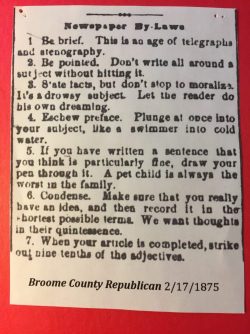Timeless: Newspaper Bylaws from 1875

Key news-writing principals remain relevant today, even as publication methods and delivery systems evolve. An article entitled “Newspaper By-Laws,” written nearly 150 years ago, provides an excellent example. The unbylined article appeared in the Broome County Republican on February 17, 1875, and it exists on microfilm available through interlibrary loan from the New York State library. Here are those bylaws, with my commentary following:
- Be brief. This is an age of telegraphs and stenography.
- Be pointed. Don’t write all around a subject without hitting it.
- State facts, but don’t stop to moralize. It’s a drowsy subject. Let the reader do his own dreaming.
- Eschew preface. Plunge at once into your subject, like a swimmer into cold water.
- If you have written a sentence that you think is particularly fine, draw your pen through it. A pet child is always the worst in the family.
- Condense. Make sure that you really have an idea, and then record it in the shortest possible terms. We want thoughts in their quintessence.
- When your article is completed, strike out nine tenths of the adjectives.
What do you think? Well, if you’re like me, you might believe that although these standards are timeless, not everyone follows them today—not in these times of corporate ownership and the aisle between editorial and sales no longer being sacred. Here are my comments on the seven points above. I hope I don’t violate any of the bylaws:
- Be Brief: The direction for brevity only needs updating regarding the delivery system—that being the internet and mobile devices, rather than print.
- Be pointed: When you’re interested in a subject, and you’ve done tons of research, there’s this impulse to dump everything you’ve learned on your audience. The reader wants to get as much information in the least amount of time possible. Save your many details for opportunities to compose a longer piece.
- State facts: The admonishment not to moralize should be heard by everyone reporting news today, especially the all-day, all-night television news programs. The concept of simply reporting the news has gone out the window, and opinion has replaced it. For myself, I don’t really care what the person, who was hired to read the news, thinks about the topics. Just give me the facts, [insert gender identity].
- Eschew preface: First, to eschew is to shun. I have a tendency to write inductively, so the reader has to wait to find out the point. Why should they be expected to trust me to make their time spent worthwhile? I hope I’ve done a better job in this article.
- Pet child: This is one I have trouble with. If I’ve written a darling of a sentence, why would I strike it? In writing, it’s not about me. It’s about the reader. Only keep that darling if you’re sure your audience will embrace it as tightly as you do.
- Condense: This is especially important today, with many blog posts containing only 400 words and the average attention span shorter than ever. A perfect example is the many Internet articles preceded by the estimated number of minutes they take to read.
- Adjectives: They have gotten nearly as little respect as adverbs, which some believe you should never use. I’m not the best at even thinking up adjectives, and personally, I admire writers who use them effectively. While neither should be overused, there are whispers of appreciation for adverbs and adjectives lately.
So, there you have it. How do you think those 1875 newspaper bylaws hold up today? Do you agree or disagree with my comments? What can you add about your own experience?




Leave a Reply